Plan checklist
The McLean Property
Gallaugher Island, Lake Vernon
Planting plan created by The District Municipality of Muskoka
Schedule A:
Plants & Property
Land Characteristics
This planting plan is designed based on the land characteristics identified during the day of the site visit. Plants are chosen according to the soil and light conditions on your property. The number of plants chosen for each planting compartment takes into account the square metre area of the space, as well as the amount of current vegetation cover. Your property is part of ecoZone: 5b
Land Characteristics by Compartment
| Length | Width | Area | pH | Soil | Moisture | Light | Height | |
|---|---|---|---|---|---|---|---|---|
| A | 6.2m | 2m | 12.4m2 | acidic | loamy, clay | normal | full sun, partial sun | |
| B | 2m | 3m | 6m2 | acidic | clay | normal, moist | full sun | |
| C | 13.2m | 3m | 39.6m2 | acidic | loamy, clay | normal | full sun, partial sun | |
| D | 12m | 3m | 36m2 | acidic | loamy, clay | normal | full sun, partial sun | |
| 33.4m | 2.75m | 94m2 |
Plant Selection Summary
The following shrubs and trees are chosen for their suitability and survivability given the current soil and light conditions in each compartment on your property, as well as preferable features.
| Plant Species | A | B | C | D | Potted | Bareroot | Wildflower |
|---|---|---|---|---|---|---|---|
| Bebb Willow | 3 | 1 | 4 | ||||
| Speckled Alder | 2 | 3 | 5 | ||||
| White Pine | 1 | 1 | 1 | 3 | |||
| Chokecherry | 2 | 1 | 3 | 6 | |||
| Shining Willow | 3 | 2 | 3 | 8 | |||
| Narrow Leaved Meadowsweet | 4 | 4 | 3 | 11 | |||
| Nannyberry | 3 | 3 | 6 | ||||
| Red Osier Dogwood | 2 | 2 | 4 | ||||
| Pussy Willow | 3 | 3 | |||||
| Subtotal | 8 | 8 | 13 | 21 | 50 | 0 | 0 |
| Totals | 50 | ||||||
Plant Information
The following table summarizes key information about each plant selected for your property.
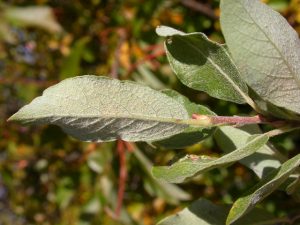
|
Bebb WillowHeight: 5 m
The Bebb Willow is a mid-sized deciduous shrub species that can grow up to 5 m in height. This plant may also be known by the common names Beaked Willow and Diamond Willow. The leaves are alternately arranged, dull green in colour, have wrinkled and hairy undersides, are narrow and elliptic in shape (but broad for willow), and have toothed margins. The bark is reddish or grayish-brown in colour and may have diamond-shaped patches along the main stems. The catkins are light green or yellow coloured and appear with the leaves between May and June. The roots can useful for controlling erosion and stabilizing shorelines.
|
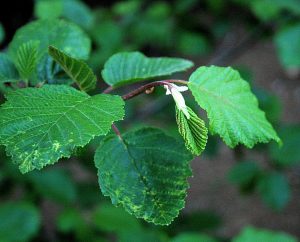
|
Speckled AlderHeight: 8m
The Speckled Alder is a large shrub species which can grow to 8m. This species produces alternate, egg-shaped, and double-toothed leaves with prominent veins. The stem initially begins reddish-brown and hairy, becoming dark brown and hairless with age. The bark also develops prominent orange-white speckles as it matures, hence the common name. The Speckled Alder produces male and female catkins on the same tree. Wingless nutlets drop from the female catkins during autumn. This species is ideal for rehabilitation applications because its roots contain nodules with nitrogen fixing bacteria, which converts nitrogen to a usable form and increases this nutrient in the soil. Speckled Alder requires moist soils and can usually be found in wet organic swamps, along shorelines, and in moist hardwood forests.
|
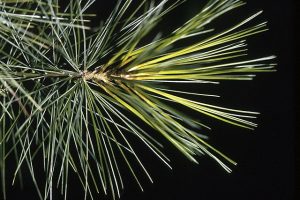
|
White PineHeight: 30m
The White Pine is Ontario's provincial tree. This species is the largest northeastern conifer with soft and light needles, which typically grows 30m in height. The needles are bundled into groups of 5 and are spirally spread around the twigs. White Pine bark is smooth and grey-green when young, becoming dark grey and deeply furrowed upon maturation. This tree produces yellow-green seed cones which are long, cylindrical, and covered in 50-80 scales. Unfortunately, this species is susceptible to White Pine Blister Rust and attacks by the White Pine Weevil. White Pine is a hardy tree which can tolerate a wide range of soil conditions, from sphagnum bogs to dry sandy and rocky ridges.
|
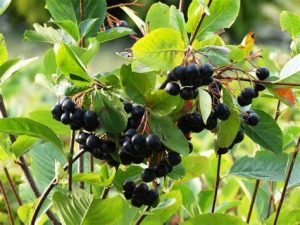
|
ChokecherryHeight: 6-9 m
The Chokecherry is a large deciduous shrub or small tree which grows between 6 and 9 m tall and is a member of the Rose family. It produces a twisted or crooked trunk as well as a narrow, oval to round crown composed of many slender branches. Leaves are alternately arranged, simple, have a deep green upper surface, and light matte green undersides with tufts of hair at the vein axils. During the fall, foliage turns a vibrant deep red to fire yellow or orange. Between May and June, small showy white flowers grow in cylindrical clusters on the terminal ends of branches. By mid-August, flowers turn into shiny deep red or black cherries, which hang in elongated clusters. The fruit is ripe by September and provides a food source for birds and small mammals. The Chokecherry is often found as pure stands forming thickets, or mixed with other early succession shrub and tree species. This fast-growing plant can quickly invade logged land, abandoned farms, and exposed shorelines. The fibrous and wide-spreading root system of this shrub make it an ideal plant for erosion control and bank stabilization. This species possesses the ability to withstand moderate flooding and drought.
|
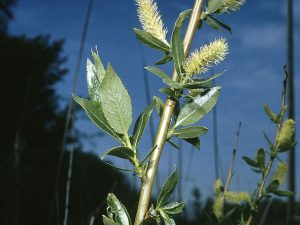
|
Shining WillowHeight: 10m
The Shining Willow is a relatively large deciduous shrub, which grows up to 10 m in height. The shiny leaves are 5-11 cm long and 1-5 cm wide, which are what give this Willow its name. They are lance shaped, with dark green color on the top, and light green on the bottom. Flowers bloom from May to June and range in colour from yellow to a green/brown.
|
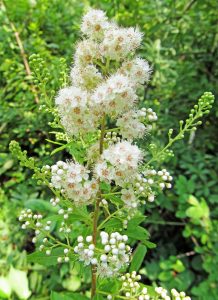
|
Narrow Leaved MeadowsweetHeight: 1-2m
The Narrow Leaved Meadowsweet is an erect, deciduous shrub, which grows in the shape of a mound to a height of 1-2m. This species develops numerous branches and branchlets, giving it a sparse appearance. Leaves produced are simple and narrow with sharply toothed borders growing alternately along the branches. These bright, light green leaves appear crowded, as they grow close together on the stocks and branches. During the fall, leaves turn a yellow-red or yellow-orange colour. Small white to light pink flower clusters appear in the spring growing in a dense, narrow pyramid at the terminal ends of the branches. During late summer to early fall, these flowers produce smooth, papery seed pods.
|
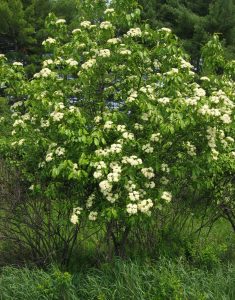
|
NannyberryHeight: 3 m
Nannyberry is a large deciduous shrub species that typically grows about 3 m in height. The leaves are dark green, ovate shaped, oppositely arranged, have a pointed tip, and have finely toothed margins. The flowers are showy, white colored, appear in flat topped clusters, and bloom in May. These flowers produce blueish black berries, which are edible to humans and persist throughout the winter. The flowers are beneficial to pollinator species , like bees and butteries. The fruit is beneficial to wildlife species, including birds and small mammals. This shrub has attractive fall foliage. The root system is extensive, making this plant valuable for controlling erosion and stabilizing loose soil. This shrub can be pruned to have a single stem and grown as a small tree instead of a shrub.
|
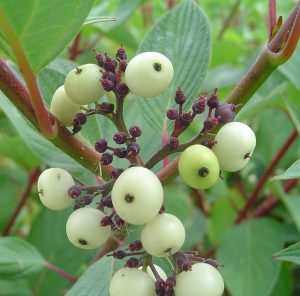
|
Red Osier DogwoodHeight: 1.5-4m
The Red Osier Dogwood is a medium-sized, deciduous shrub native throughout Northern and Western North America which typically grows to 1.5-4m. This species is multi-stemmed with numerous erect and ascending bright red branches that create a loose and spreading form. Leaves produced are simple, two-toned with a dark green upper side and light green underside. They are arranged opposite each other along the branches. During the fall, the foliage turns a brilliant red to dark purple. Clusters of small, creamy white flowers form on the terminal ends of the branches between June and July. The Red Osier Dogwood produces blueish-white fruiting bodies during late summer, which may persist throughout the winter. This shrub's berries provide an important winter food source for numerous species, from large deer to small wintering birds.
|
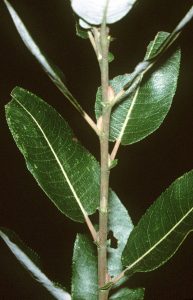
|
Pussy WillowHeight: 6m
The Pussy Willow is a fast growing, deciduous shrub or small tree found reaching heights of 6m, and is from British Columbia to Newfoundland. This species grows from shoots extending from the base of the trunk, creating a multi-stemmed, tall, round bush. The Pussy Willow is an ideal species for bank stabilization and erosion control due to its large, fibrous root system and love of water. This species branches extend from the main shoots and are usually hairy and reddish-brown in colour. The main shoots of Pussy Willow are smooth and greyish-brown, becoming scaly with age. It produces simple, narrow, lance-shaped leaves alternately arranged along the branch. The Pussy Willow yields purple-brown fuzzy catkins which will form long-beaked and finely haired capsules during May and June.
|
Compartment A
Naturalization Area
Erosion issues on the slope pH: acidic
pH: acidic Depth: potted
Depth: potted-
 Moisture: normal
Moisture: normal -
 Soil Type: loamy, clay
Soil Type: loamy, clay -
 Light conditions: full sun, partial sun
Light conditions: full sun, partial sun
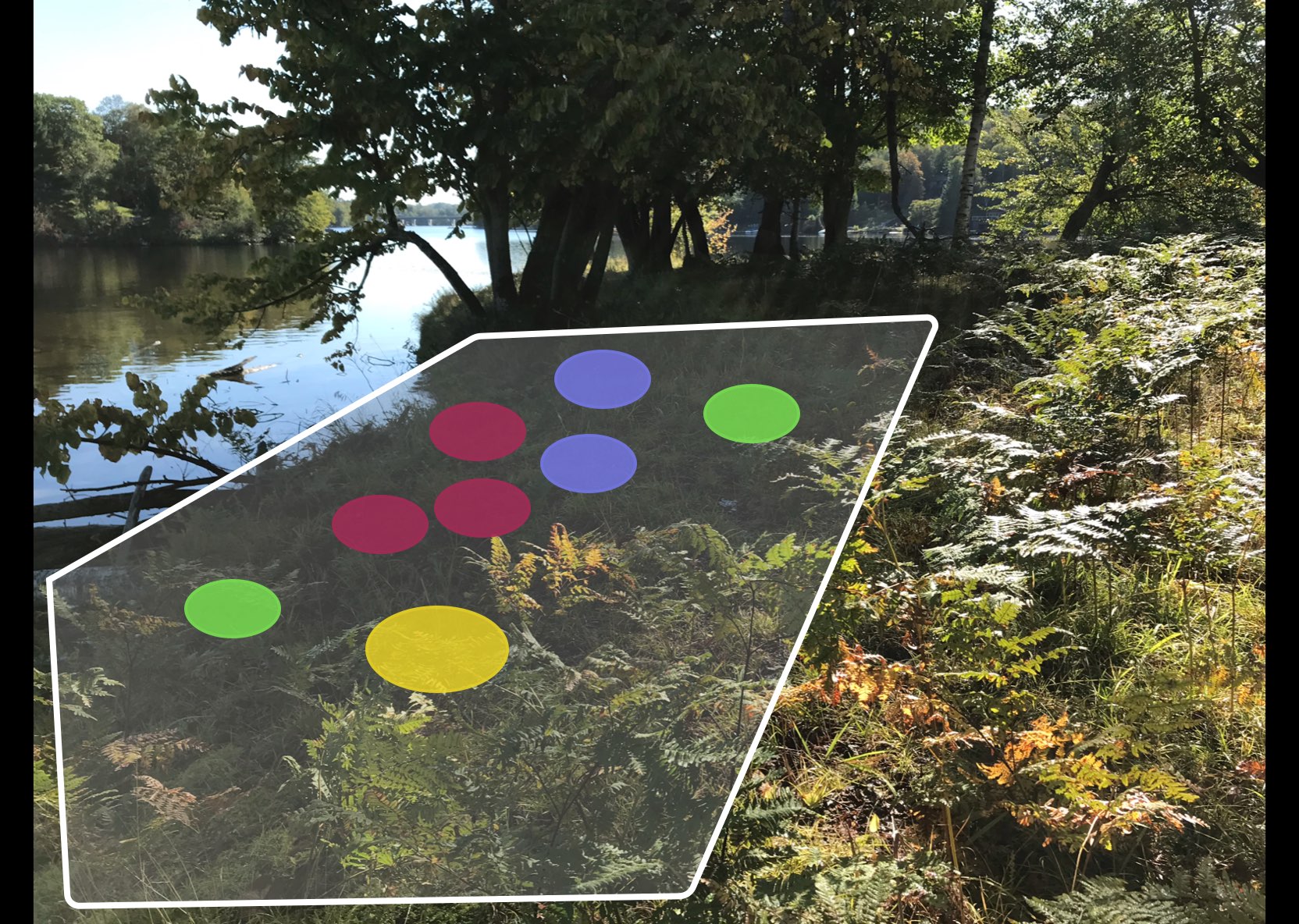
Compartment B
Naturalization Area
Bank erosion; sedges pH: acidic
pH: acidic Depth: potted
Depth: potted-
 Moisture: normal, moist
Moisture: normal, moist -
 Soil Type: clay
Soil Type: clay -
 Light conditions: full sun
Light conditions: full sun
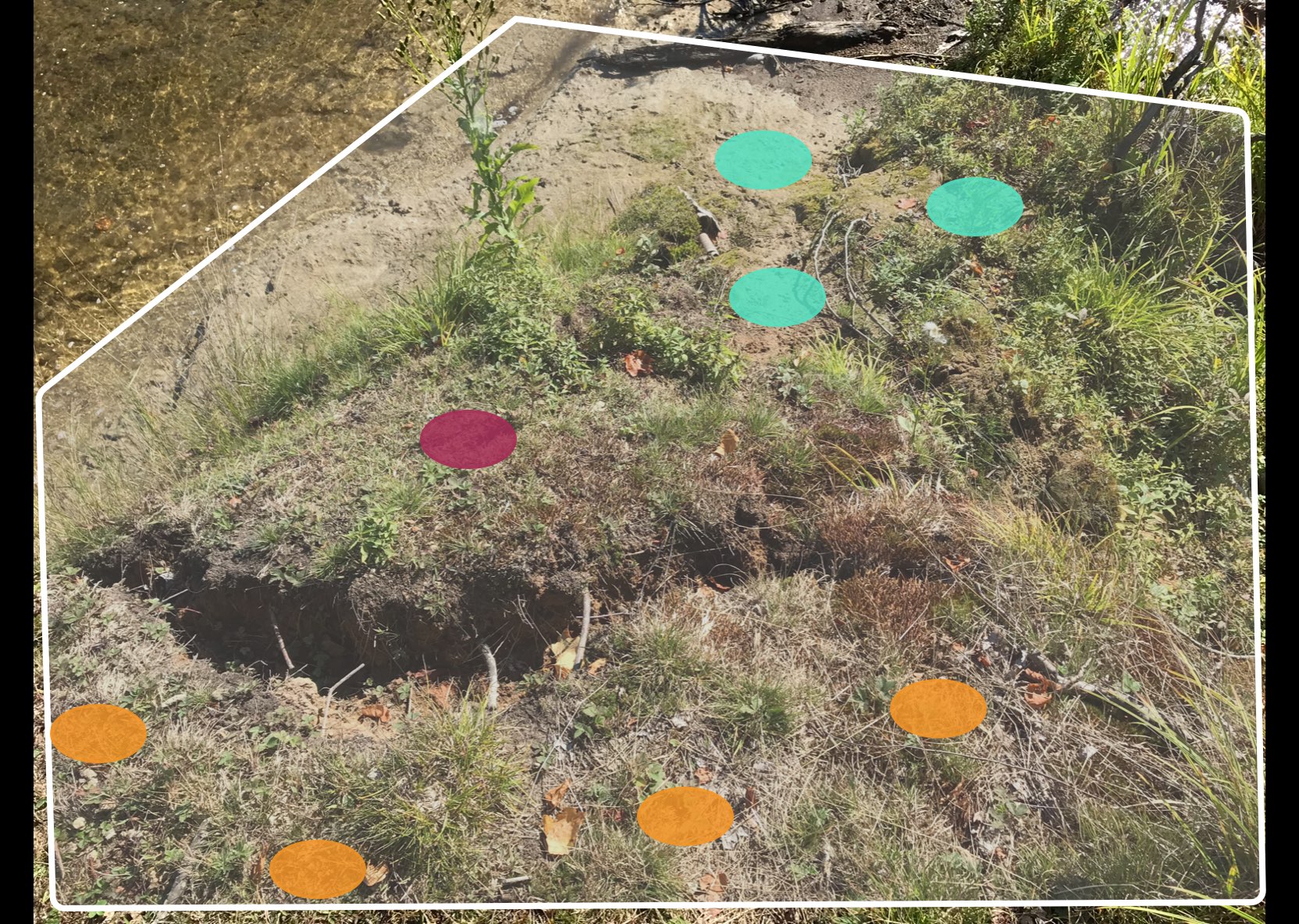
Compartment C
Naturalization Area
Bank erosion pH: acidic
pH: acidic Depth: potted
Depth: potted-
 Moisture: normal
Moisture: normal -
 Soil Type: loamy, clay
Soil Type: loamy, clay -
 Light conditions: full sun, partial sun
Light conditions: full sun, partial sun
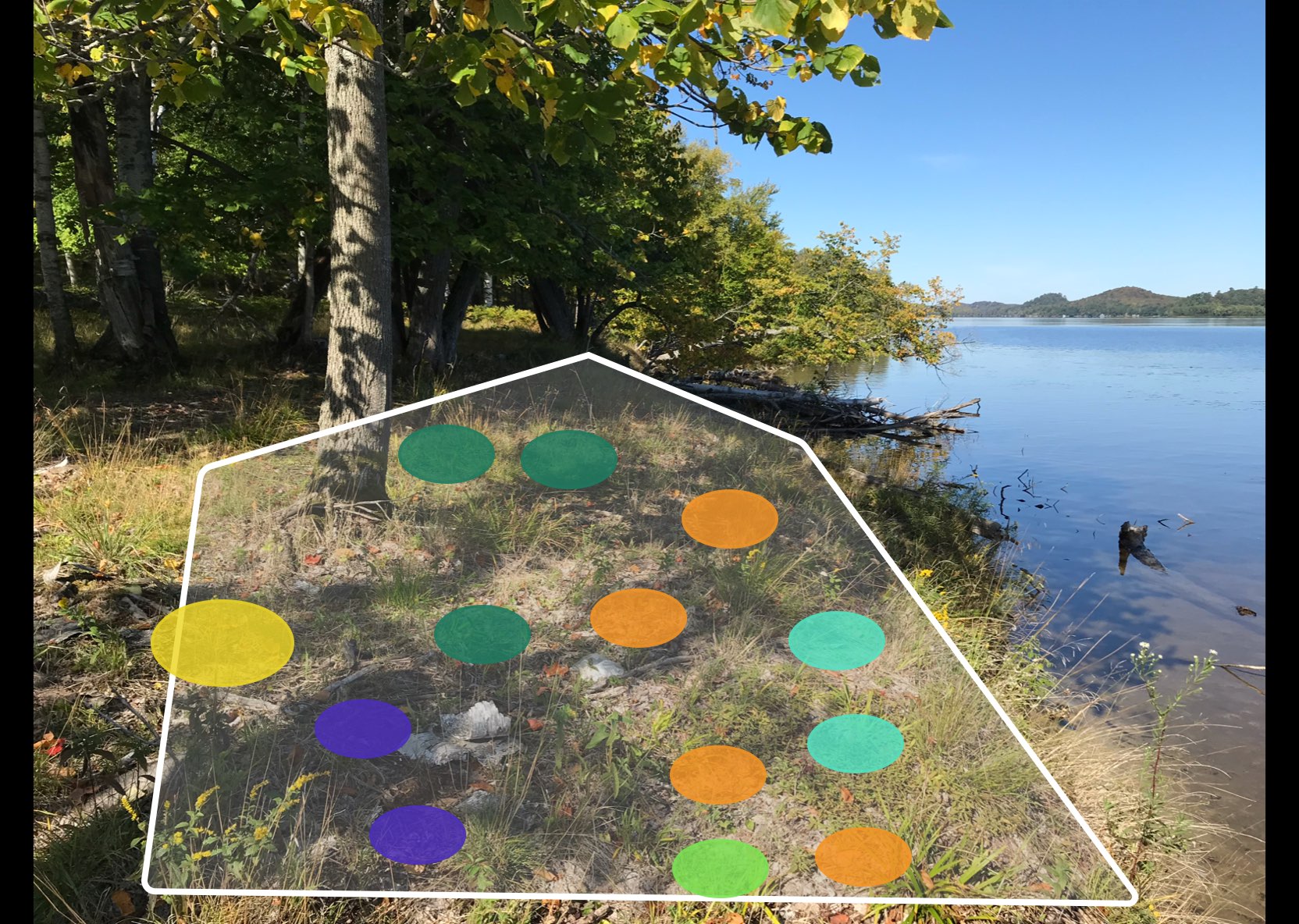
Compartment D
Naturalization Area
Bank erosion pH: acidic
pH: acidic Depth: potted
Depth: potted-
 Moisture: normal
Moisture: normal -
 Soil Type: loamy, clay
Soil Type: loamy, clay -
 Light conditions: full sun, partial sun
Light conditions: full sun, partial sun
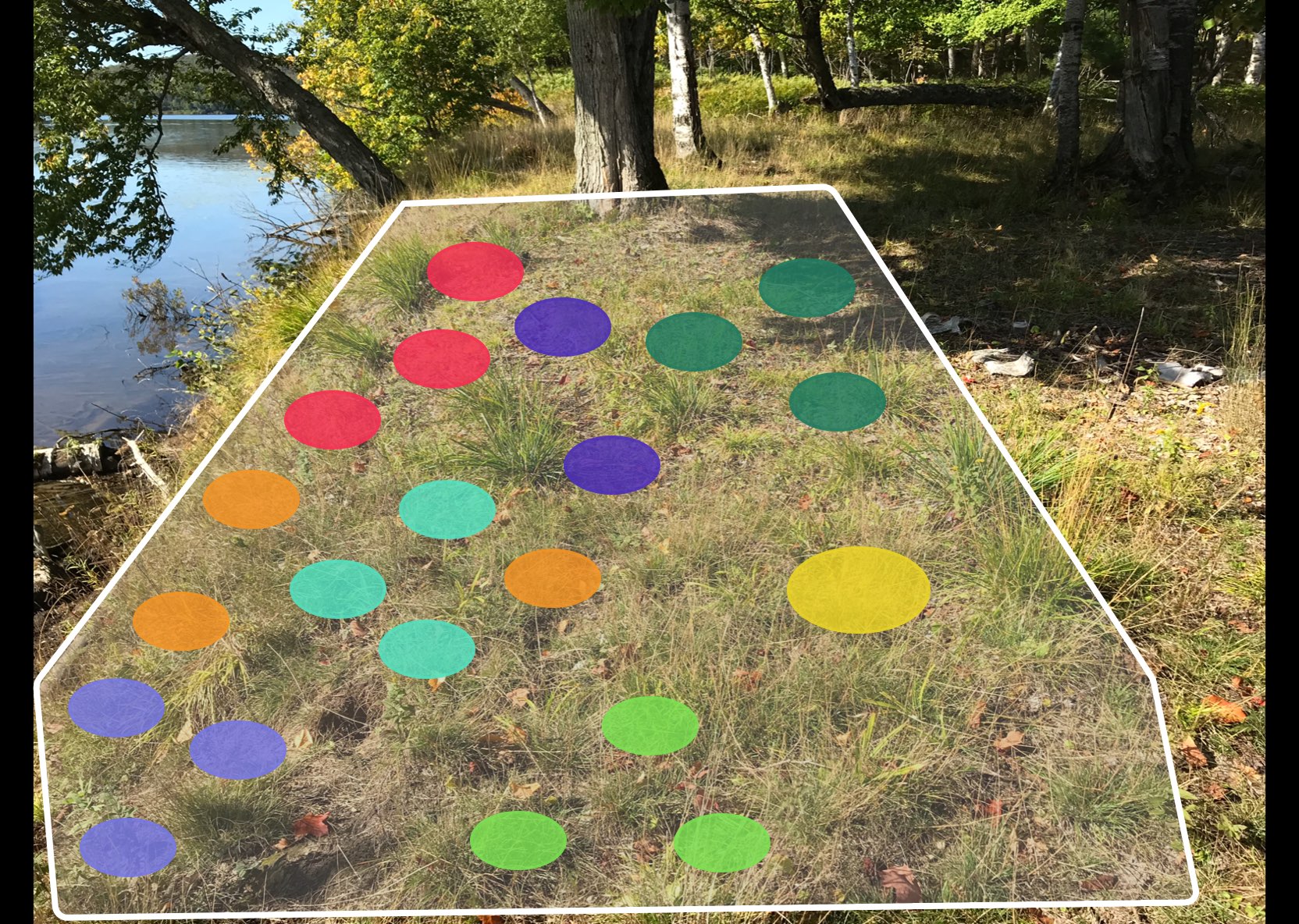
Schedule B
Financial Summary
Project by: The District Municipality of Muskoka
Shoreline Re-Naturalization Starter Kit includes: free site visit, customized re-naturalization planting plan for your shoreline property, native plants including free bare root (small) and potted (large) plants and wildflowers, coconut fibre pads to deter grass from growing around new plantings, tree guards for all deciduous trees, mulch for your wildflowers, Plant Care Guide with instructions on how to take care of your new plants, Habitat Creation Guide and a Wildflower Garden Guide.
Our planting plans are created onsite with you and provide detailed information and plans to re-naturalize your shoreline property. We take photos of areas for planting and overlay native plants that are well suited to your property based on site conditions such as soil type and sunlight availability.
We will work with you to create a plan that works for you including options for low growing plants in areas where views are important.
| Item | Quantity | Cost/Item | Subtotal |
|---|---|---|---|
| Starter Kit fee | $300 | ||
| Free potted plants | 20 | $0 | $0 |
| Paid potted plants | 30 | 12.00 | 360.00 |
| Free bareroot plants | 0 | $0 | $0 |
| Free wildflowers | 0 | $0 | $0 |
| Total costs | 660.00 |
Schedule C
Project Agreement
Stewardship Agreement
Please indicate your agreement to this proposed plan by signing the following Stewardship Agreement and submitting it, along with your financial contribution, to:
The District Municipality of Muskoka
70 Pine Street
Bracebridge, Ontario
P1L 1N3
Plant Availability
Please note that plant species may need to be changed based on plant stock availability at the time of ordering.
Project Completion
Upon receiving your signed stewardship agreement and financial contribution, a date will be booked for you to pick up your Natural Edge Kit. The District Municipality of Muskoka will supply all plants and materials. If you are paying for the planting to be completed for you, a date will be arranged for The District Municipality of Muskoka to plant your shoreline, bringing the plants and materials with them. If there are particular dates that you would prefer, we will do our best to accommodate your requests.
The Natural Edge Stewardship Agreement with The District Municipality of Muskoka
Agreement made this 18th Day of the Month of September in the Year 2019.
BETWEEN Don McLean Gallaugher Island Ontario (Hereinafter called the OWNERS)
AND The District Municipality of Muskoka 70 Pine Street Bracebridge, Ontario P1L 1N3 (Hereinafter called DMM)
WHEREAS the Owners and DMM have met and discussed plans for shoreline naturalization on the specified area(s) in Schedule A existing on the Owners’ land;
WHEREAS the Owners indicate approval of the project as proposed; and
WHEREAS the project is, or will be for the benefit of the Owners and others;
NOW THEREFORE THE PARTIES AGREE AS FOLLOWS:
1. This Agreement shall be in effect for a period of 5 years, commencing with the date of this Agreement.
2. The Owners and DMM agree that the areas where the work is to be performed is as described in Schedule A.
3. The Owners agree to pick up their Natural Edge Starter Kit from DMM’s office and plant their shoreline within two days of receipt. The Owners will provide “after” photos of the work completed to be used for reporting purposes. If the Owners wish to have the planting completed for them, then DMM or it’s contractors, employees and agents will complete the planting at cost, as indicated in Schedule B.
4. If the planting is to be completed by DMM, then the Owners grant DMM, its contractors, employees and agents, the right to enter the property to perform the work agreed upon as outlined in Schedule A. In addition, DMM, its contractors, employees and agents may inspect the work performed for the purposes of monitoring the project and survival assessment, with prior agreement with Owners for date and time of inspection.
5. The Owners agree to contribute the “Landowner contribution” and pay the costs indicated in Schedule B.
6. In instances where the Owners are to pay DMM for work to be performed (outlined in Schedule A), the Owners agree to provide payments to DMM prior to the commencement of that operation. Failure of payment shall constitute a breach of this Agreement and the Owners agree that this Agreement will be terminated and thereupon the Owners agree to pay DMM the estimated costs of the operations of the project completed to date, if any.
7. The Owners agree, if necessary, to perform a reasonable amount of maintenance, which is described in the Native Plant Care Guide, available at naturaledge.watersheds.ca.
8. If a contractor is required to perform the work outlined in Schedule A, then the contractor carrying out the work on the land described will be required to take out and furnish evidence of a comprehensive policy of public liability and property damage coverage. The contractor and their workers will be required to be in good standing with the Workplace Safety and Insurance Board (WSIB) prior to performing the work.
9. The Owners agree not to remove, destroy or alter the project without prior consultation and approval of DMM. Pruning and trimming planted nursery stock, or adding replacement native nursery stock is exempt.
10. The Owners agree not to mow the planted area.
11. The Owners do acknowledge that DMM, its contractors, employees and agents, having performed said works, are not under further obligation with respect to survival of nursery stock, inspection, or maintenance.
12. The Owners, in the absence of negligence, hereby remise, release and forever discharge DMM, its contractors, employees and agents from all claims and demands for injuries, including death, loss, damages and costs in any way related to or connected with installation and maintenance of the work described or resulting from any deleterious effects of the work to the land or to the lands and buildings thereon retained by the Owners.
IN WITNESS WHEREOF the parties have agreed to the contents of this plan; SIGNED:
About this program
About The District Municipality of Muskoka
The District of Muskoka is an upper-tier municipality that has monitored water quality in Muskoka area lakes since 1980. Since 2002, the Muskoka Water Strategy has provided integrated and strategic initiatives for the protection of Muskoka's water resources. The purpose of the strategy is to guide and minimize the impact of human activities on water resources; ensure human and environmental health; and preserve the quality of life in Muskoka.
This program was created by Watersheds Canada
We believe that every person has the right to access clean and healthy lakes and rivers in Canada. At Watersheds Canada, we work to keep these precious places naturally clean and healthy for people and wildlife to continue using for years to come. We love working with others to meet the needs of local communities, whether you’re a concerned citizen, a landowner, a lake association looking for help, or a coalition of groups interested in activating your local community.

